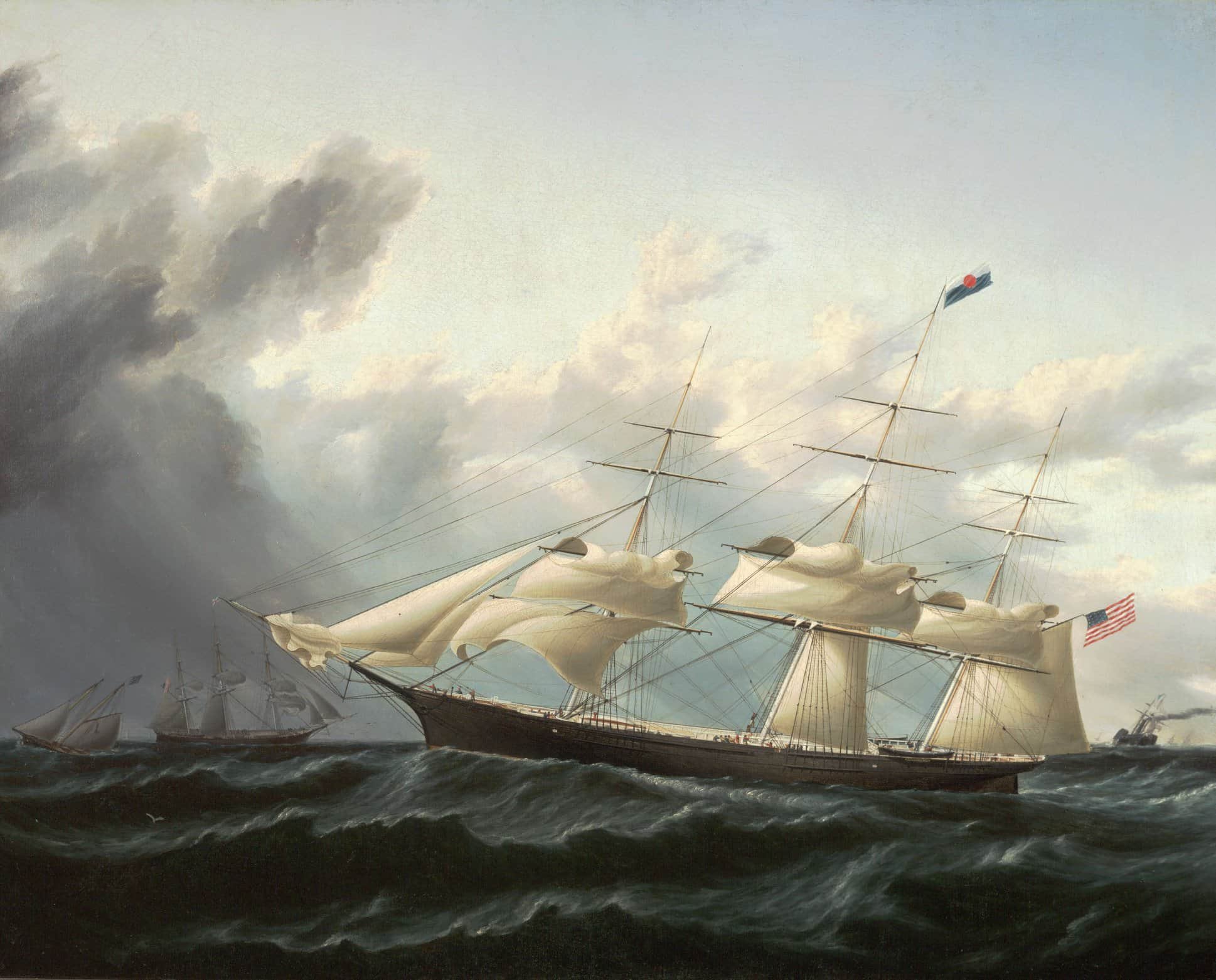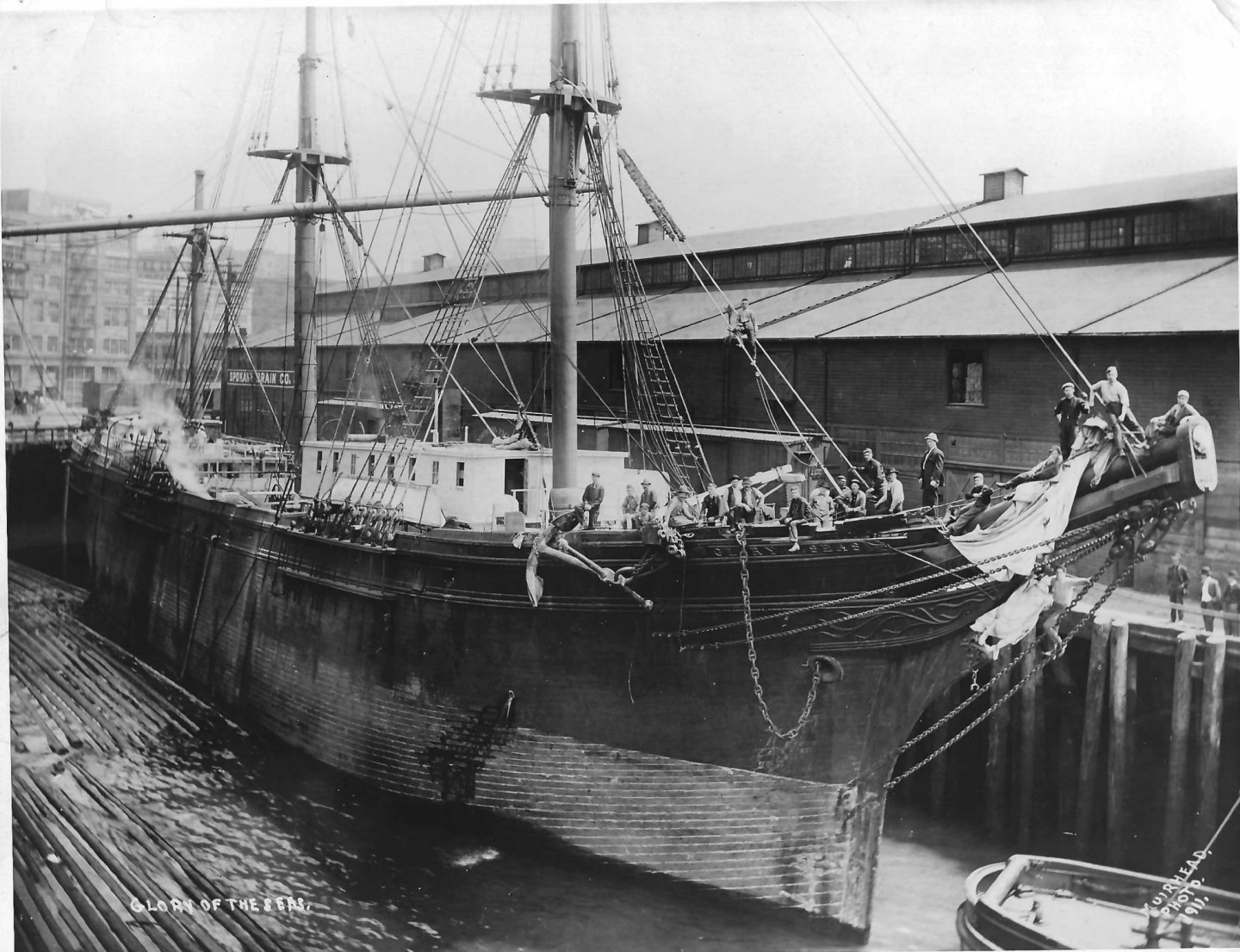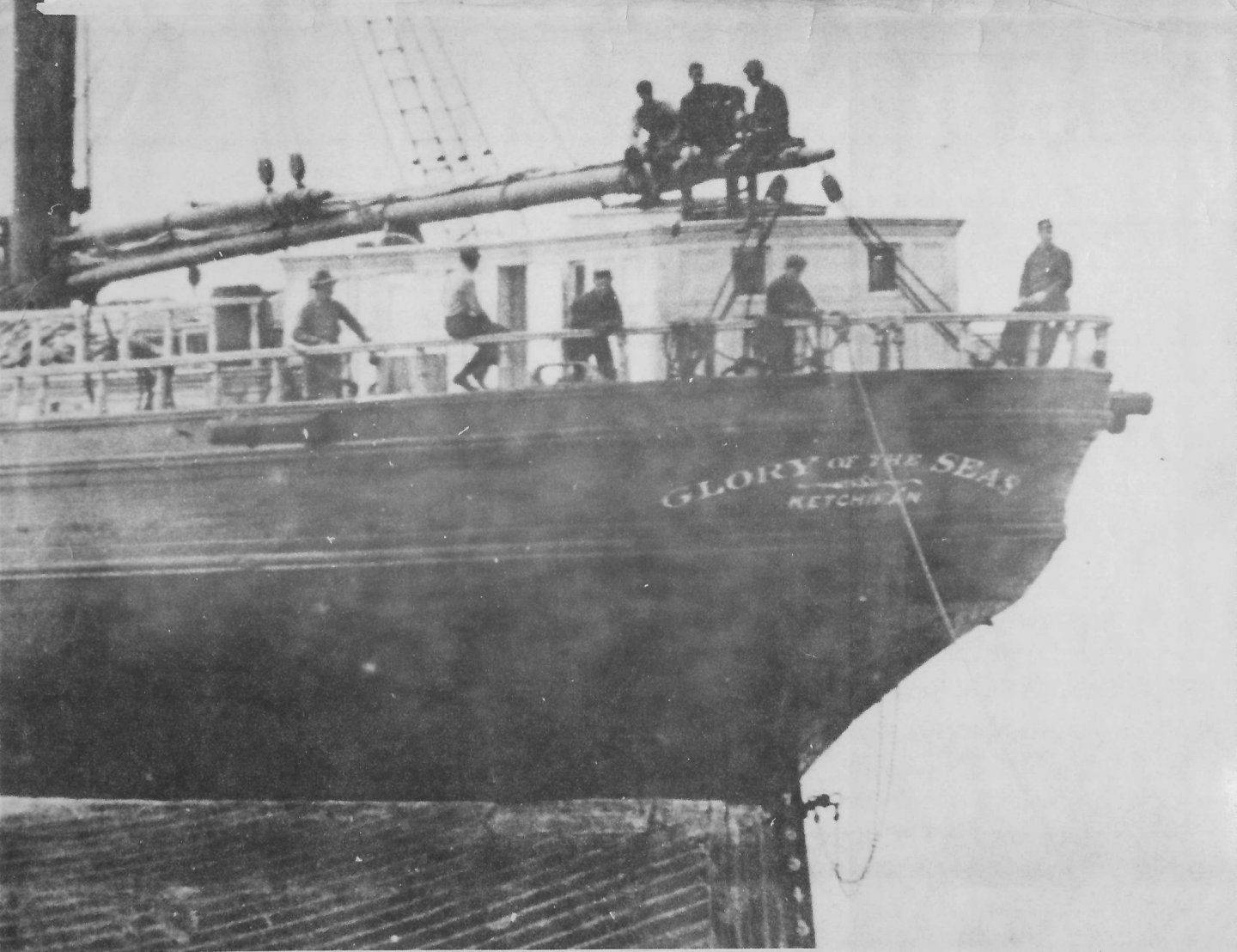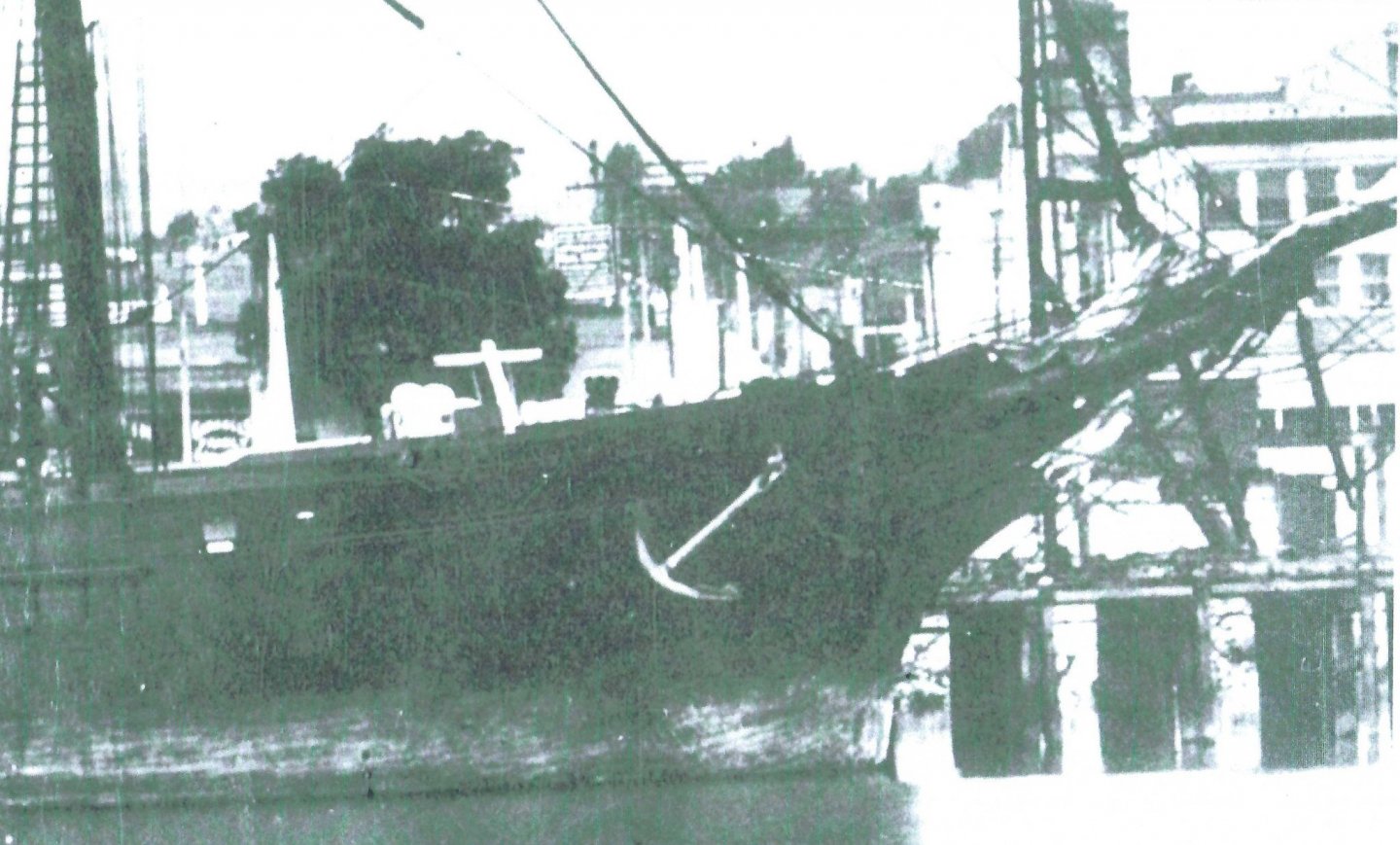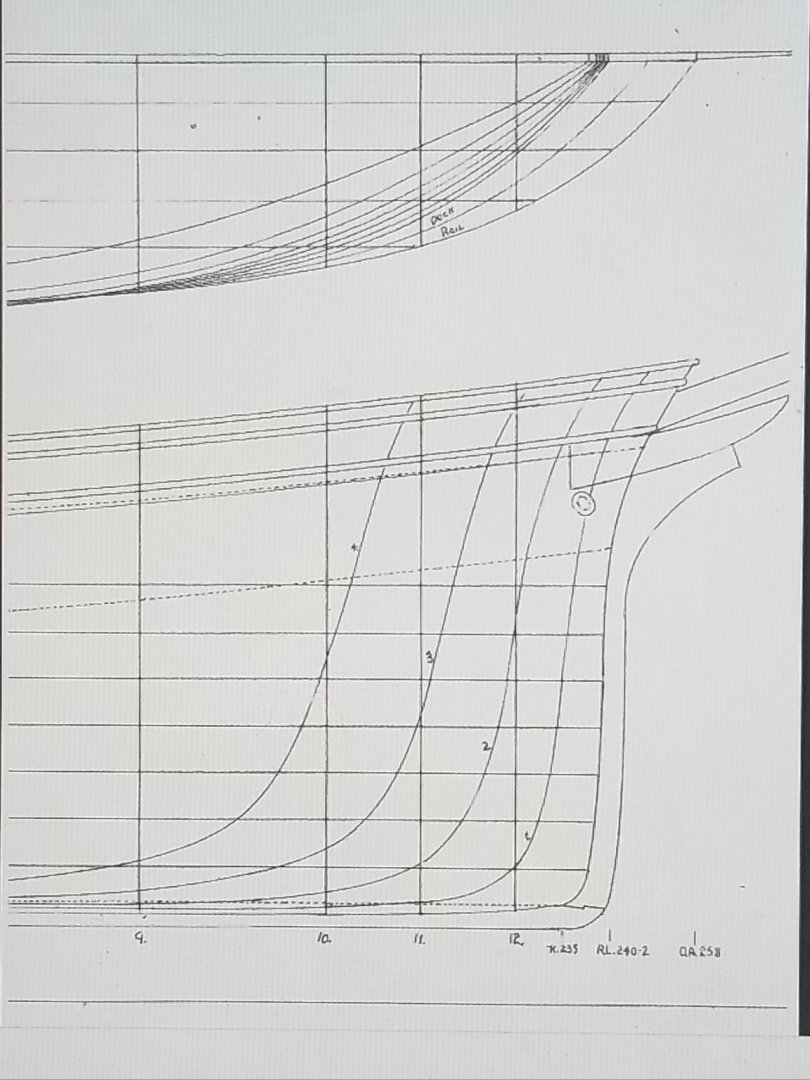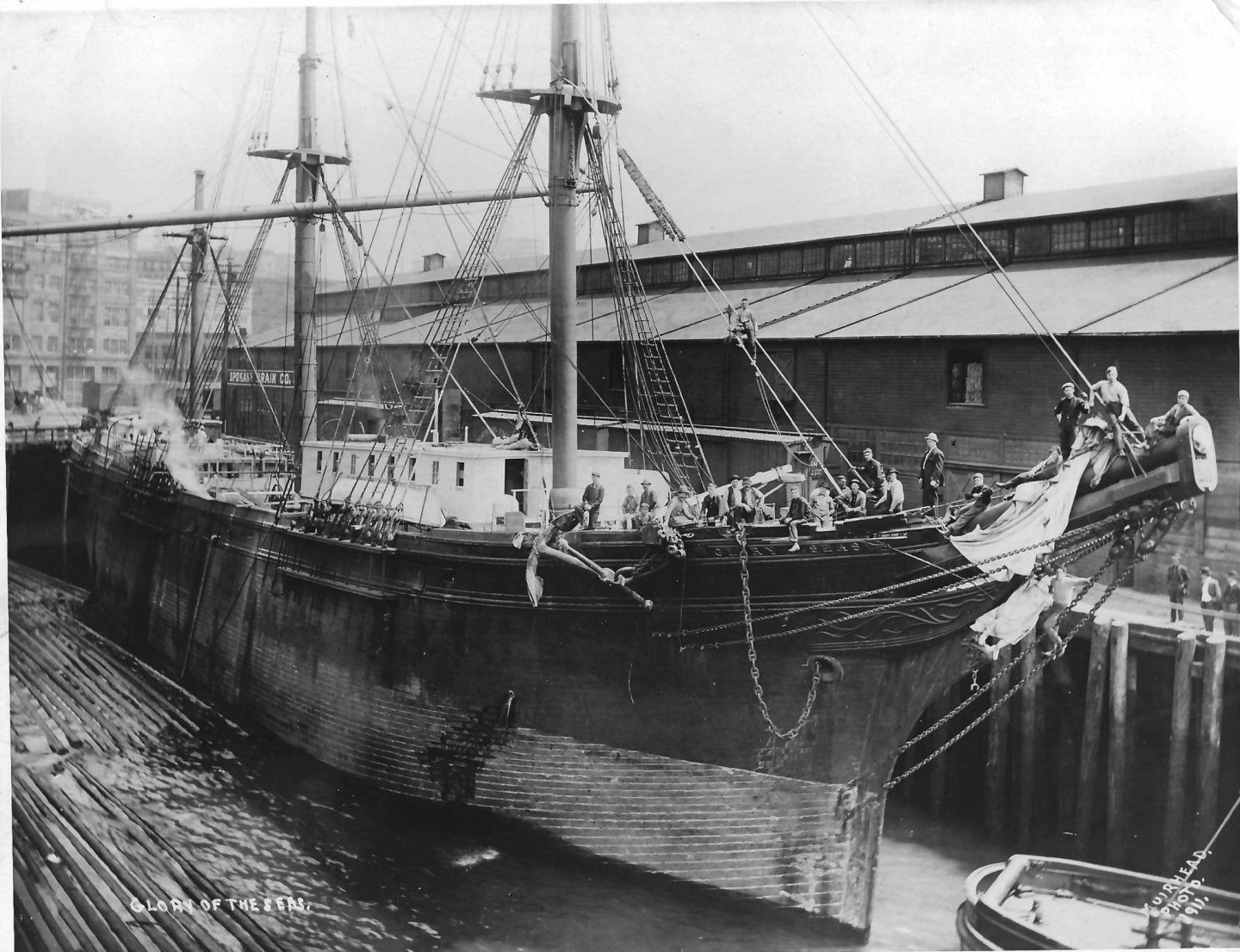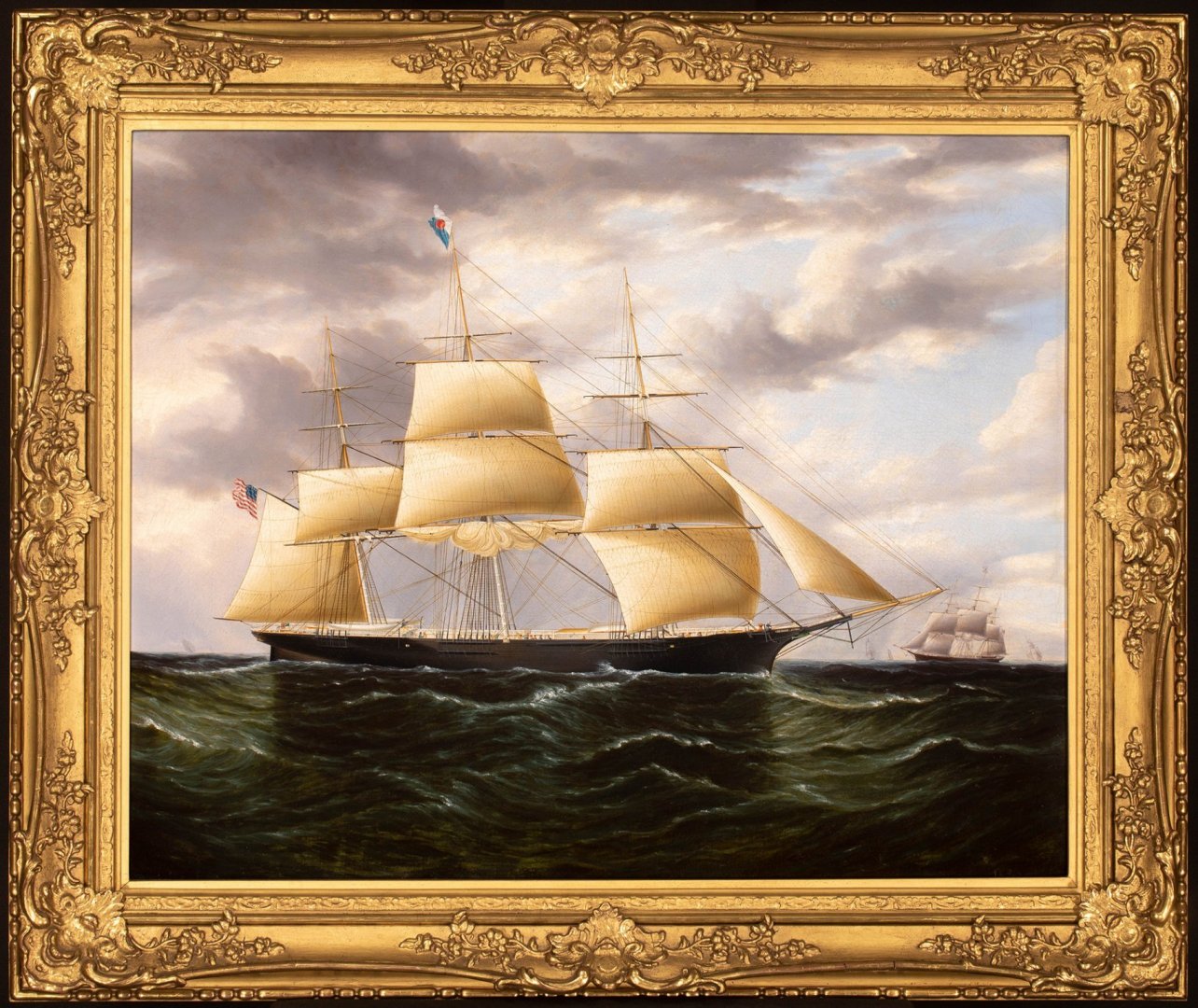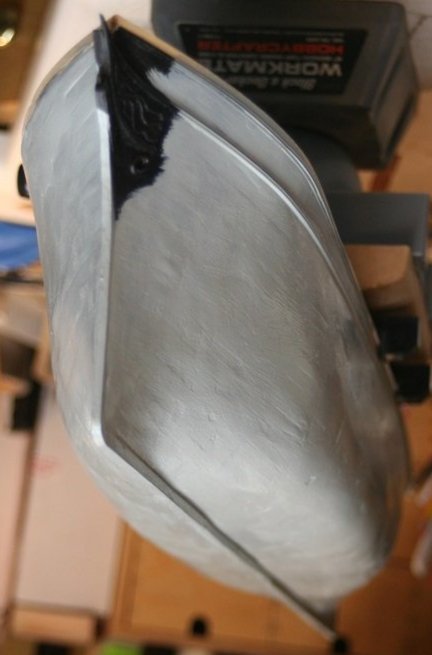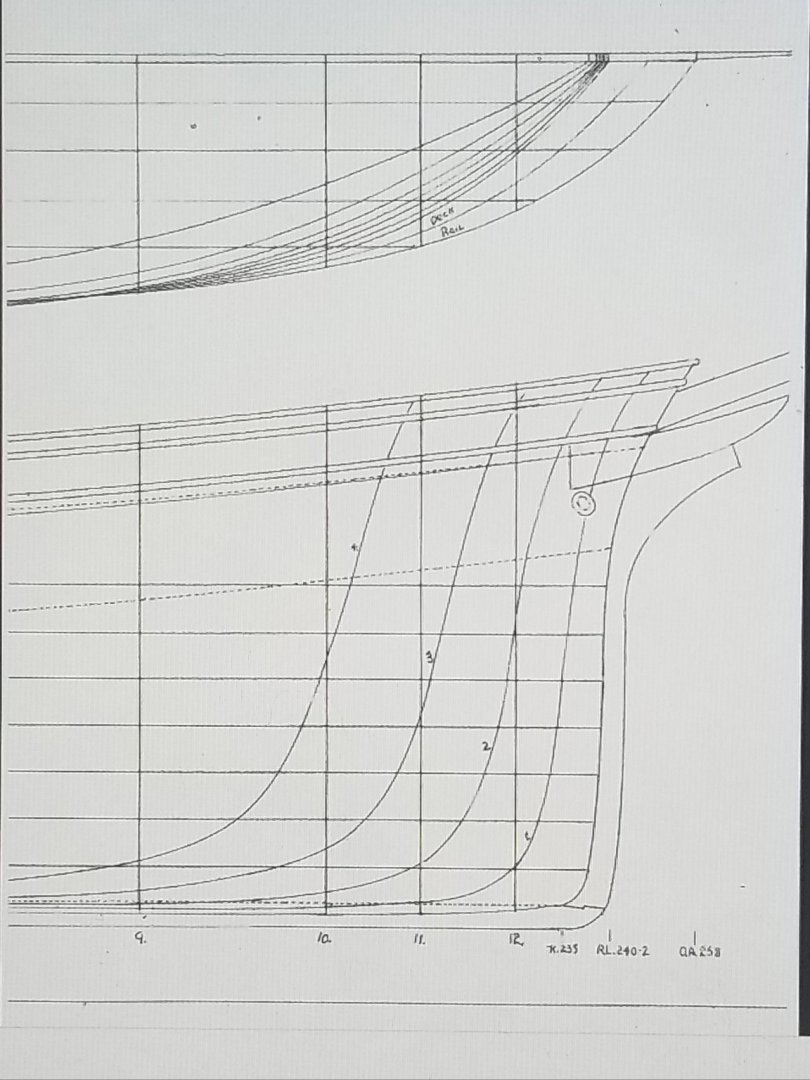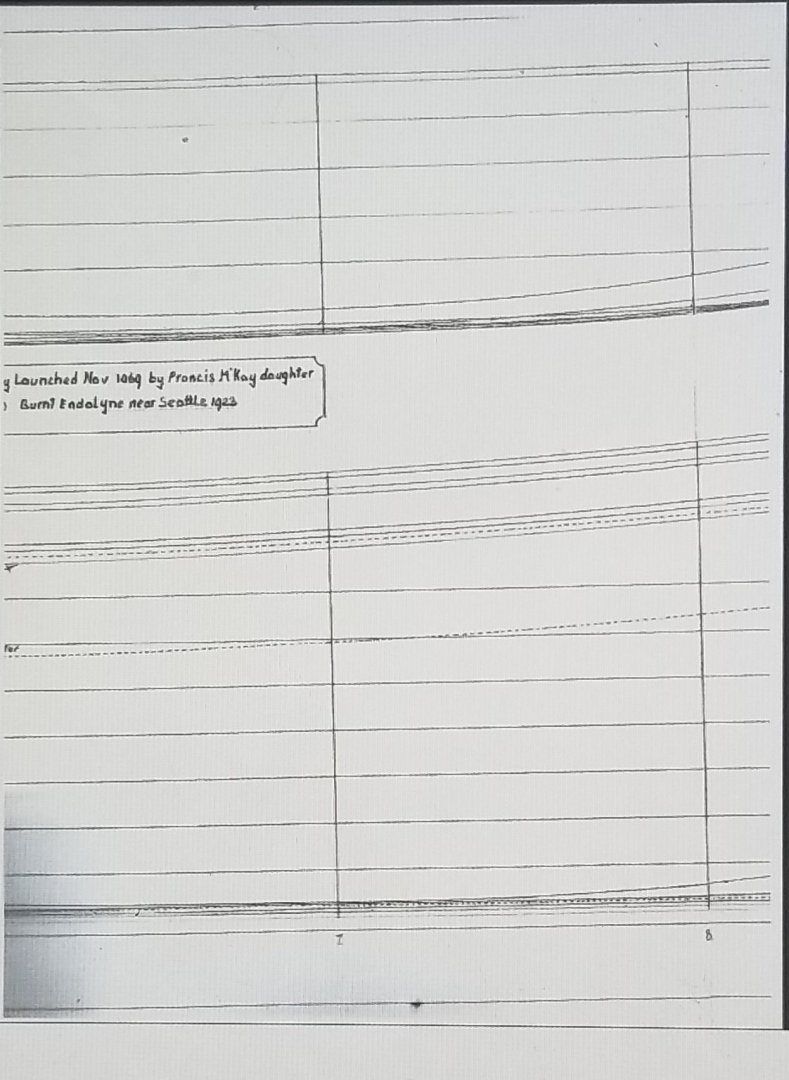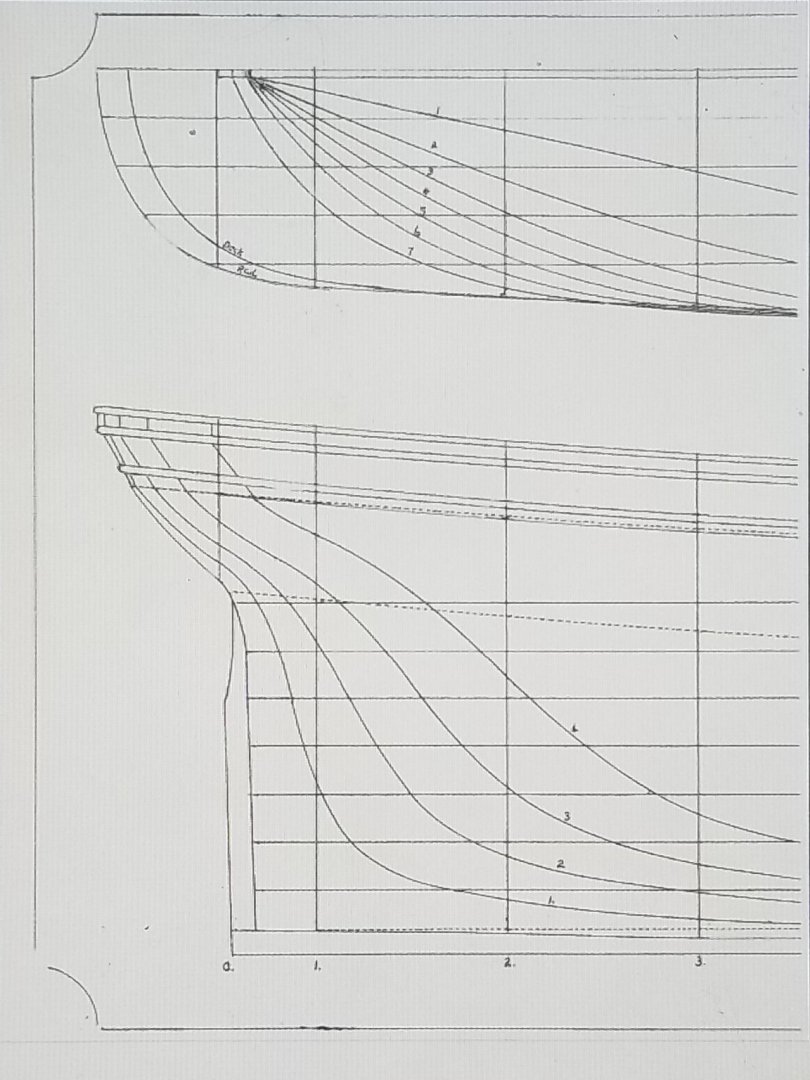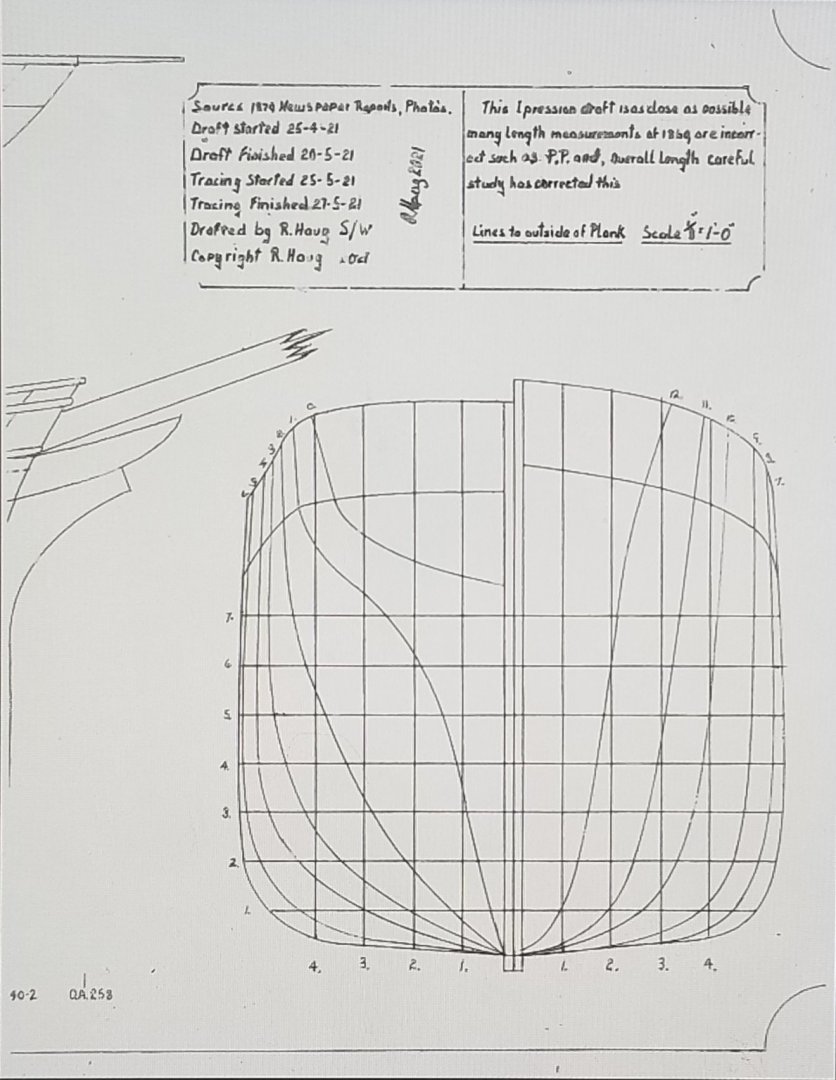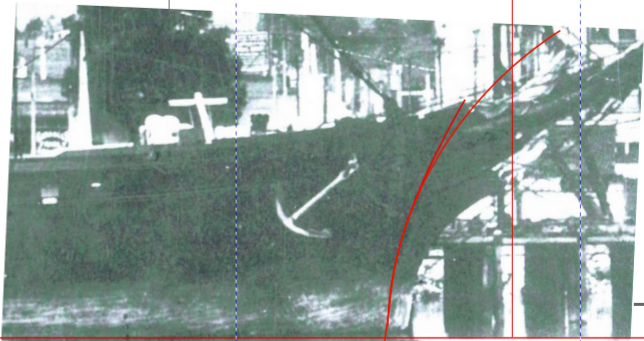-
Posts
2,152 -
Joined
-
Last visited
Content Type
Profiles
Forums
Gallery
Events
Everything posted by ClipperFan
-
Rob, while your Stern is probably the most accurate ever realized in a Glory model yet, it is lacking one distinctive component of the real ship. Look closely below the sheerline and you'll see another more subtle line. I now believe this is a 3'6" drop, coinciding with the lower Naval Hood molding. That would mean that while it isn't so clearly distinguishable across her entire Hull it's still there. If you go back to McKay's illustration of his Twin Packets "Star of Empire & Chariot of Fame" that same thin line is there too. I surmise that perhaps this might be a mounting line for all of the wrought Iron shrouds as well.
- 3,560 replies
-
- clipper
- hull model
-
(and 2 more)
Tagged with:
-
Rob, that is spot on! You simply have to share these with Michael Mjelde. I have a feeling he will be blown away! I completely agree with Vladimir's expression, as he put it succinctly and perfectly "My God, it's her!"
- 3,560 replies
-
- clipper
- hull model
-
(and 2 more)
Tagged with:
-
gak1965 thanks for sharing something new with me. I never read the book you mentioned. It comes as a complete surprise that McKay originally considered painting "Flying Fish" green. Perhaps that's why Duncan MacLean made the wry observation that like Clergy, Clippers always come in Black. As for the Cutwater, that's a nautical device that always mounts on the Stem. Unfortunately, while this is an impressive kit which builds into a beautiful model, I believe the Bow is inaccurate. A figurehead tacked on with nothing to support it would be lost with the first wave. Better to have it incorporated into the end of the Cutwater, which is how Buttersworth has depicted her.
- 602 replies
-
- Flying Fish
- Model Shipways
-
(and 2 more)
Tagged with:
-
Rob, the very fact that your Hull form, even incomplete bears such an amazingly close resemblance to various contemporary photos of "GLORY of the SEAS" is all the proof we need to validate that the lines our combined group arrived at are accurate. I am thrilled to observe you and Vlad's inspiring progress.
- 3,560 replies
-
- clipper
- hull model
-
(and 2 more)
Tagged with:
-
Rob, I deeply appreciate your well wishes. As I painstakingly recreate my understanding of Glory's true lines, I will share them here first. I intend to include references to every single piece of photographic evidence which supports the lines drawn. Hopefully, it should be such a compelling body of documentary evidence that it will lead Mike and Ron to reevaluate Glory's true appearance.
- 3,560 replies
-
- clipper
- hull model
-
(and 2 more)
Tagged with:
-
guys, I am so frustrated by this stupid situation. I'm determined to finally get Glory's lines right but I'm still battling post op pain to recover and can't seem to concentrate on drawing. So maddening. Two days ago, I was so frustrated with my lack of progress that I went "cold turkey" and quit taking pain meds. Dubious decision for sure with expected results that I hurt like a son of a bitch but I feel like if I can just get beyond this grueling crucible my return to normalcy will accelerate. Then you will once again see my contributions of how Donald McKay's last, longest lived beautiful Clipper Ship "GLORY of the SEAS" (NOT an 1830s Packet Ship) truly appeared.
- 3,560 replies
-
- clipper
- hull model
-
(and 2 more)
Tagged with:
-
Rob, Vladimir, honestly how can anyone see the two clear pictures of the lovely, sleek prow of "GLORY of the SEAS" and come up with these proposed lines??? It just doesn't make any sense to me. I know Ron's a highly accomplished artisan, as witness by his gorgeous half Hull of "Donald McKay" but he just still seems to be so far of the mark for poor Glory!
- 3,560 replies
-
- clipper
- hull model
-
(and 2 more)
Tagged with:
-
Rob, while I'm relieved that Ron is reworking the Stern, quite frankly I as usual have a huge problem with his interpretation of Glory's Bow. My God, he actually has her prow bulging slightly forward below the waterline! What's up with that??? His Naval Hoods don't match and that should easily be fixed by looking at the lovely close up which clearly shows both the hoods and her Cutwater. Then there's her 7' sheer, which I see nowhere in his lines. I do not in anyway want this to turn into a p--sing match but his latest effort still is so far off from where we've arrived at. However I strongly feel Mike needs to know the truth. Especially if he plans on publishing these in his latest book. Honesty to me is always the best approach but how do you gracefully tell an experienced shipwright that his lines totally suck, again???
- 3,560 replies
-
- clipper
- hull model
-
(and 2 more)
Tagged with:
-
Rob, I was trying to envision you somehow using steel wool or brillo pads, which obviously made no sense. Thanks for clarifying it.
- 3,560 replies
-
- clipper
- hull model
-
(and 2 more)
Tagged with:
-
Rob, I'm unfamiliar with the wool stem process for the transom. Is that a typo? I know about steam bending but not the procedure you described. Can you please enlighten me?
- 3,560 replies
-
- clipper
- hull model
-
(and 2 more)
Tagged with:
-
Vladimir, my sensitive wife Peggy is constantly on me for my dry humor. She's right of course. More often than not, others don't realize I'm merely joking. It's tough to tone it down because I'm having harmless fun when I do it and can't seem to accept that people hear it differently. Of course I wasn't serious about you and Rob being in any kind of a modeling race, that would just be plain silly. Besides which, as I've mentioned more than once, I personally have never seen a modeler produce such impressive results in such short time. In my own dumb way I was attempting to encourage you in your own endeavours as you build what I'm sure will be a fine model of "GLORY of the SEAS."
- 3,560 replies
-
- clipper
- hull model
-
(and 2 more)
Tagged with:
-
Vladimir my friend, after seeing how the actual "Cutty Sark" Museum, Greenwich, England has requested the honor of placing your massive 1:24th Clipper "Cutty Sark" for public display, I have no doubt you will give Rob quite a "run for the money!" Just remember too, especially in modeling at this fine level of meticulous accuracy, entirely scratch building from self developed ship's lines, sometimes slow & steady wins the race too. .
- 3,560 replies
-
- clipper
- hull model
-
(and 2 more)
Tagged with:
-
gak1965 I'm friends with Vladimir & just stumbled on your impressive build. I hope you don't mind my sticking my 2c in but I might have some fascinating historical information to enlighten you about the amazing accomplishment of the Clipper "Flying Fish" you're currently building. Being a Scottish Immigrant from Nova Scotia, Donald McKay was very conservative and remarkably consistent in his paint schemes for his Clipper Ships to the point of being boring. Non other than Duncsn MacLean, the Boston Daily News publicist even made a jocular observation that all of McKay's Clippers, like Clergy came in Black. There are others that were painted quite differently. For instance the fast Clipper "Galatea" which had a distinctive full running thoroughbred painted on her fore topsail, was painted deep Sea Bronze. Of course it's your vessel, you can paint her as you choose but I thought you might appreciate knowing something about the Historic nature of this particular McKay Extreme Clipper. I've attached a gorgeous painting done by the famous contemporary artist James Buttersworth commissioned by the Ship's owners to celebrate this McKay vessel's triumphant win in the "Great Deep Sea Derby". The painting confirms that, like "GLORY of the SEAS" where we actually have photographic proof, the large rear cabin does indeed overhang about 3' from the rear poop deck. The painting also verifies that the rear of the cabin is flat, not curved. Another fascinating detail is her sea bronze & gold trimmed flying fish figurehead. It is most likely smaller than the kit supplied version. If you observe closely, you can see it is apparently embossed on the vessel's Cutwater which mounts over the stem. The beautiful model kit much like "Flying Cloud" seems to include only the Stem not the Cutwater which mounts over it. Since these Clippers were built to take on the heavy seas of Cape Horn, Donald McKay made the Bow extremely rugged. This arrangement makes for a much more stable and graceful Bow than the rather awkward way the figurehead is sort of tacked on with nothing to support it. https://www.vallejogallery.com/item_mobile.php?page=item_page&id=487#lg=1&slide=4
- 602 replies
-
- Flying Fish
- Model Shipways
-
(and 2 more)
Tagged with:
-
Rob, this is indeed Donald McKay's Clipper "GLORY of the SEAS" shaping up in all her glory. To see his last Clipper come to life in three dimensional miniature like this is so thrilling to observe, especially after spending the last year viewing tantalizing images of her. Two dimensional photos just don't do her Justice. I've selected two of my favorites of the many pics you've shared. Most impressive is the top one where you can see the graceful transition from sharp Clipper Bow to full bodied Merchantman. The bottom image has been flipped in order to better appreciate the loveliness of her form. My one request, I know it's purely a matter of taste, is that you reconsider leaving the waterways light blue. I personally appreciate the contrast with pearl and white trim, besides which it seems to have been a preferential hallmark of practically all of Donald McKay's Clipper Ships
- 3,560 replies
-
- clipper
- hull model
-
(and 2 more)
Tagged with:
-
Vladimir, CONGRATULATIONS!!! on the Cutty Sark Museum request to display your impressive, large scale model. While you no longer possess this magnificent creation, I encourage you to contact whoever holds it to see if they might like to honor the Museum's request. Knowing how most collectors feel, it's almost a sure bet they too would appreciate the opportunity to see their miniature in display at the home of the actual vessel herself. If nothing else, besides raising monetary value for any potential future resale, bragging rights alone would also be a positive motivator. If you haven't informed the new owner, I strongly encourage you to do so. They might be thrilled and thank you for letting them know. Good luck!
-
Rob, recovery progress is continuing to be the toughest of my life but I am slowly, determinedly improving. I also want to admit Rob that I am truly humbled by your generous compliment. I had no idea that you held my viewpoint with such high regard. Meanwhile, I personally continue to be in awe of your rapid, yet beautifully accurate modeling skills. Such careful attention to small details like the multiple moldings of Glory will result in what I am now convinced will be the most impressively accurate miniature of "GLORY of the SEAS" ever produced so far. Lacking anywheres near the modeling skills of either you or Vladimir, I want to only act as a guide to assist you both in realizing your objectives to achieve the most accurate reproductions possible. It has been the thrill of a lifetime to collaborate with other fans of Donald McKay's incredibly beautiful Clipper Ships, especially being able to communicate with one of my favorite Maritime authors as well. So It's damnably frustrating to be sidelined by my slow recovery, especially since I feel an even greater sense of serious urgency to redo accurate lines of "GLORY of the SEAS" to finally do her true justice. After doggedly pursuing real genuine faithful reinterpretation of Donald McKay's last glorious Clipper Ship for just over twelve and a half years now, I refuse to accept seeing another set of unfortunately crappy lines be published that do McKay's brilliance such an injustice. What we have learned from over a year's worth of intense study and exhaustive evaluation of practically every inch of McKay's longest lived merchant vessel has been so encouraging and enlightening. Our mutual approach has consistently relied on precise, scientific, measured investigation of every incredibly clear image so generously shared by author Michael Mjelde. I personally am firmly convinced that what Donald McKay accomplished in his final effort was the culmination of his decades of single minded pursuit of excellence in creating a very swift merchant vessel with an extremely sharp Clipper Ship entrance and exit coupled with an enormous capacity for storage as well. Remember this amazingly durable Clipper was the very last vessel to accomplish the arduous Cape Horn journey from New York to San Francisco in under 100 days (1873-74 in 96 days - Pacific Marine Review). She also still holds the record for sailing from San Francisco, California to Sydney, Australia in 35 days, a feat accomplished despite poor vessel condition, as the Ship herself was crank due to insufficient ballast. With a strong beam wind Glory was practically on her beam ends. As a result the crew had to send down her stunsail booms as well as royal yards. Yet despite such poor vessel condition, she sailed with very favorable winds and weather (Pacific Marine Review). Imagine what she might have accomplished if she had been in proper trim. Now it's time to pull all that intense detailed research we have done together into one coherent whole and produce a recognizable blueprint of what she truly looked like.
- 3,560 replies
-
- clipper
- hull model
-
(and 2 more)
Tagged with:
-
Rob, your progress is so exciting to watch. "GLORY of the SEAS" is now definitely looking like the Clipper Ship I see in the many impressive images Mike has shared with us. I'm glad you revised the scrollwork for her Cutwater and Naval Hoods. This image here is my favorite one of your latest ones. The form is simply beautiful. Great work!
- 3,560 replies
-
- clipper
- hull model
-
(and 2 more)
Tagged with:
-
Ron Haug's proposed new line impressions for Donald McKay's Clipper Ship "GLORY of the SEAS" as sent to Rob and I a few days ago. Ron told Mike that in this design, he believes that somehow McKay has "drifted back to his old Packet Ship days of the 1830s even with the stem" with this design. Honestly, I'm personally very sad to say "here we go again." My impressions of Shipwright Ron Haug's lines are that he either never saw the incredibly detailed photos Michael Mjelde's shared with us or he doesn't see the same svelte vessel we see. Our past year's collaborative effort has led me to hope for so much more than... this. While this group has been concentrating on reconstructing Glory's true form for about a year, my own journey of discovering Donald McKay's last Clipper Ship has now been just over a dozen. I don't know how Mike will react but as I've always consistently said, my first loyalty is to the memory of Donald McKay and his lovely vessel. Mr McKay deserves better.....
- 3,560 replies
-
- clipper
- hull model
-
(and 2 more)
Tagged with:
-
1869 Donald McKay Clipper "GLORY of the SEAS" 2,102 tons Specifications Length of Keel: 240'2" Line of the wales between perpendiculars: 250' Overall length, Knightheads to taffrails: 265' Breadth of beam: 44' Depth of hold: 28'6" Height between decks: 8'2" Deadrise at half floor: 8 1/2" Overall sheer: 7' As I race to incorporate all the particular specifics Rob, I and others of our dedicated group have confirmed, these are the historic, published specifics I will be relying on. Besides length of keel, sourced from Glory's official registry admeasurement, all other measurements are from Duncan MacLean's 1869 published description of the vessel in the Boston Daily Atlas.
- 3,560 replies
-
- clipper
- hull model
-
(and 2 more)
Tagged with:
-
Fortunately, Mike's going to be concentrating much of his time promoting his latest book "Down East Captain." That should give us valuable time to build a strong case to refute, then hopefully refine Ron Haug's interpretation of Glory's Hull, section by section. Meanwhile I have far more confidence in the vessel's lines as we have scientifically arrived at through full utilization of every possible resource available to us. After seeing Ron Haug's stunning half hull of "Donald McKay" and his beautiful model of the Downeaster "Benj F Packard" I respect his talents and ability. How he has so far so badly misinterpreted "Glory of the Seas" is maddeningly frustrating.
- 3,560 replies
-
- clipper
- hull model
-
(and 2 more)
Tagged with:
-
Rob, I just now opened up Mike's email & viewed Ron Haug's "Glory of the Seas" lines impressions. After our solid year of exhausting, in depth research, utilizing some of the sharpest, clear images, courtesy of Michael Mjelde's incredible collection of images of Glory's Hull, I have to admit I'm disappointed and somewhat baffled as to how Mr Haug has come to his conclusions. It makes me seriously wonder, is he even seeing the same pictures we have been given? I hope this doesn't upset Mike but I vehemently disagree with Ron's Bow interpretation. His rough drawn Nava Hoods alone don't match the crystal clear image of that device as seen in the 1912 extreme broadside close up. The Cutwater is way too thick below. Then the graceful flowing curve of the Cutwater which transitions to the sharp, slightly backwards angled prow is completely missing. Instead, Ron's prow appears to bulge slightly forward which completely contradicts the 1912 Seattle scene where Glory's sharp Clipper prow can be evidently seen, with much of her re-coppered below waterline Hull visible as well. Meanwhile, I also totally disagree with Ron's much thicker Stern as well. Again, it's like he's not seeing the slimmer, graceful refined Counter and Stern that we have worked so hard to replicate. There's definitely a defining line most likely 3'6" below the sheerline which can be clearly seen in both the Alaska towing scene and even the 1869 fitting out image. Then there's the sheerline itself. Again, the amount of drop from the Stern going forward appears to be more significant than that seen on the vessel herself. Then there's the ship's dimensions written on Ron's lines. Keel, depth of hold and beam all agree precisely with those published by MacLean but deck length of 235' is 20' shy of that published and 258' overall length is 7' shorter than that published of knightheads to Taffrail of 265'. I'm going to redouble my efforts to produce lines of my own, incorporating everything we have discovered with our concentrated efforts to realize a far more accurate Clipper Ship. Donald McKay deserves to finally have his last Clipper Ship done faithfully.
- 3,560 replies
-
- clipper
- hull model
-
(and 2 more)
Tagged with:
-
Rob, you have no idea how much it thrills me to see the amazing progress you've made on your exacting 1:96 scale "GLORY of the SEAS". Daily I look to see if there's been any new images of your build. Each time there is, it uplifts my day. It's making my recent difficult surgical procedure recovery so much easier to endure. I've wanted to make more frequent observations but just didn't feel well enough to do so. This latest, most refined version of Glory is so beautiful. Her Hull form now so closely resembles photos of the actual vessel that it's uncanny. You can see the brilliance of Donald McKay's design, in that he has a very sharp entrance yet a full massive hold in order to accommodate substantial cargo needs as well. Your carved Naval Hoods and Cutwater do an impressive representation of this very lovely aspect of her Bow entrance. My sole nitpick is you just need to somehow squeeze in a sole carved ropeline at the base of her Cutwater which so gracefully echoes the lower Naval Hood triple curved arch. As I said to Vlad, this line doesn't impede on the lovely continuous curve of the Cutwater itself. Then I can hardly wait to see this section fully realized with 24kt gold leaf which embossed all carved relief for this section. Again, thank you so much for your single minded devotion to realizing McKay's final Clipper Ship in all her true glory. It's such an uplifting and inspiring process to observe.
- 3,560 replies
-
- clipper
- hull model
-
(and 2 more)
Tagged with:
-
Vladimir, like Rob's 1:96th scale efforts your even larger 1:72nd scale Glory project is progressing beautifully. I'm particularly taken with her lovely counter which now is much more reflective of the actual vessel herself. One item which I want to help you refine is the graceful lower curve of Glory's cutwater. Look carefully at the negative space of Glory herself where you overlayed the red lines. It's a continual graceful looping curve going all the way down just beyond her lower Bobstay mount on her prow. The reverse curve of the carved arch can be confusing, as it appears to interfere with that curve but it doesn't, that's an optical illusion. Focus on the edge, you'll see what I mean. Overall, you and Rob both have impressive projects in the works.
-
Rob, I'm relieved to hear that you're ok after the worst historic heat wave in the Northwest coast ever. Never in my wildest imagination would I ever conceive of Seattle, Washington having a early Summer temperature of 118 degrees. Had I seen that in a SciFi film, I would have dismissed it as pure fantasy. I hope to God cooler temperatures prevail soon for all of you. Excessive heat, combined with high humidity can be crushing. It can be hard to breathe, even moving around can be very tiring. In such excessive conditions, a good reliable air conditioning system is a godsend. Staying immersed in water, either by swimming or frequent cool showers helps too. Sunburns can be very painful and dangerous too. If you have to be outside, cover yourself especially the back of your neck and behind your knees. Heat frustration leading to heat exhaustion can be subtle at first than hit you all at once. It starts with having trouble concentrating, can lead to godawful headaches, even light headedness and dizziness. It's best to lay down with knees bent and cold wet compresses on your head. Drink cold water like a fish. Gatorade is especially helpful as it replaces electrolytes lost to sweat. Meanwhile the progress you described on your Glory build is very exciting to read. I can't wait to see pictures! I'm finally home from the hospital after spending 19 days there. Now continues the difficult road to full recovery. Thanks for all your prayers and well wishes. They mean a lot!
- 3,560 replies
-
- clipper
- hull model
-
(and 2 more)
Tagged with:
-
Rob, Thanks. It finally feels like my body is on its full way to recovery, Thank God! I'm glad to hear you had a nice Father's Day get together with family. I never asked. Do you have kids or grandchildren? By the way. Do you know if Michael's been able to see these pics of your impressive 3rd model? I would be thrilled to see images of your and Vladimir's completed projects in his 3rd book. Probably not possible due to production timelines but it never hurts to ask. Meanwhile, on your vacation, due be careful. I hear riding in the surf can be very tricky!
- 3,560 replies
-
- clipper
- hull model
-
(and 2 more)
Tagged with:
About us
Modelshipworld - Advancing Ship Modeling through Research
SSL Secured
Your security is important for us so this Website is SSL-Secured
NRG Mailing Address
Nautical Research Guild
237 South Lincoln Street
Westmont IL, 60559-1917
Model Ship World ® and the MSW logo are Registered Trademarks, and belong to the Nautical Research Guild (United States Patent and Trademark Office: No. 6,929,264 & No. 6,929,274, registered Dec. 20, 2022)
Helpful Links
About the NRG
If you enjoy building ship models that are historically accurate as well as beautiful, then The Nautical Research Guild (NRG) is just right for you.
The Guild is a non-profit educational organization whose mission is to “Advance Ship Modeling Through Research”. We provide support to our members in their efforts to raise the quality of their model ships.
The Nautical Research Guild has published our world-renowned quarterly magazine, The Nautical Research Journal, since 1955. The pages of the Journal are full of articles by accomplished ship modelers who show you how they create those exquisite details on their models, and by maritime historians who show you the correct details to build. The Journal is available in both print and digital editions. Go to the NRG web site (www.thenrg.org) to download a complimentary digital copy of the Journal. The NRG also publishes plan sets, books and compilations of back issues of the Journal and the former Ships in Scale and Model Ship Builder magazines.

